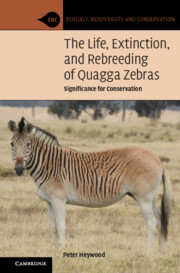Book contents
- The Life, Extinction, and Rebreeding of Quagga Zebras
- Ecology, Biodiversity and Conservation
- The Life, Extinction, and Rebreeding of Quagga Zebras
- Copyright page
- Dedication
- Contents
- Acknowledgments
- Introduction
- 1 Zebras
- 2 Quaggas
- 3 Coat Coloration
- 4 Quaggas, Zebras, and Humans in Southern Africa
- 5 Quaggas Abroad
- 6 Extinction
- 7 Afterlife
- 8 Rebreeding
- 9 Identity and Conservation
- Book part
- Notes
- Bibliography
- Index
4 - Quaggas, Zebras, and Humans in Southern Africa
Published online by Cambridge University Press: 30 April 2022
- The Life, Extinction, and Rebreeding of Quagga Zebras
- Ecology, Biodiversity and Conservation
- The Life, Extinction, and Rebreeding of Quagga Zebras
- Copyright page
- Dedication
- Contents
- Acknowledgments
- Introduction
- 1 Zebras
- 2 Quaggas
- 3 Coat Coloration
- 4 Quaggas, Zebras, and Humans in Southern Africa
- 5 Quaggas Abroad
- 6 Extinction
- 7 Afterlife
- 8 Rebreeding
- 9 Identity and Conservation
- Book part
- Notes
- Bibliography
- Index
Summary
The Khoekhoe and the hunter-gatherers of the Karoo, the |Xam, valued quagga meat, and used their hides and bones too; the |Xam told stories about quaggas and indigenous people portrayed them on rocks. This chapter describes hunting techniques of indigenous people andof the Europeans who settled in the Cape Colony. Hunting provided settlers with meat that they gave to their slaves and laborers and hides that were made into low-value items such as ropes, harnesses, whips, halters, bags, thongs, clothing, and veldschoen (rough shoes). In the nineteenth century, big-game hunters and hide-hunters joined in the killing. Settlers also used quaggas to protect their livestock and to pull wagons but this latter use was probably limited as quaggas were prone to fatigue; nonetheless, other plains zebras were harnessed with domestic equines and used to pull a stagecoach. Domestication of quaggas would have been disadvantageous as they could have harbored African Horse Sickness and this disease is transmissible by insect vectors to horses, donkeys, and mules, where it can be deadly. Quaggas did not need to be domesticated in order to be valued; biophilia could have prevented their extinction.
- Type
- Chapter
- Information
- The Life, Extinction, and Rebreeding of Quagga ZebrasSignificance for Conservation, pp. 60 - 75Publisher: Cambridge University PressPrint publication year: 2022

